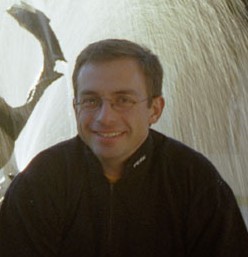
|
The simulation of all types of light scattering in a model
is called global illumination. My PhD research addressed
the simulation of
global illumination
including
caustics
by introducing the concept of
photon mapping.
The key features of the photon mapping algorithm are the use of photon tracing
and the photon map. The photon map is decoupled
from the scene geometry, and it can be used in models with millions of
objects and complex materials. Photon mapping is a very practical
technique capable of simulating
color bleeding,
caustics,
participating media,
subsurface scattering,
and motion blur.
Today, photon mapping is implemented in most high-end rendering software,
and it is being used in architectural simulations, computer games,
and movies. As an example there was a very nice
caustics sequence (light focusing through a glass of whisky) in
Final Fantasy.
I have mostly been concerned with the
caustics formed as light is focused through
a glass
of cognac.
|

|
Rendering natural phenomena is a growing area of
research in computer graphics. Recently, I worked on a physically based
model of the
night sky.
The goal of this project was to simulate all important visual elements of
the night sky (the moon, stars, the atmosphere, the Zodiacal light etc.)
including their appearance to the eye (loss of color and blue shift).
For this purpose we used multi-spectral rendering combined with an
accurate simulation of light scattering in the atmosphere. Another recent
project addresses the simulation and rendering of
smoke
and more recently we have extended this work to include
fire.
|

|
Appearance modeling is an exciting area of research
in computer graphics. Understanding the incredibly complex and diverse
appearance of materials is essential for rendering compelling images.
At MIT I worked on projects where we wanted to understand
and simulate the darkening of many
wet materials.
as well as the changes in the appearance of
weathered stone.
These projects used path tracing and photon mapping to simulate
subsurface
scattering.
The simulation of subsurface scattering is necessary to capture
the effect on the appearance due to
changes in the internal structure and composition of the materials.
Photon mapping is quite good at simulating subsurface scattering, but
it becomes costly for highly scattering materials such as milk and skin.
For these materials it is better to use a diffusion approximation. The
diffusion approximation is much faster than tracing invidual photons,
and it is simple enough that a
BSSRDF
can be formulated. The BSSRDF is particularly suited for translucent
materials where the assumptions in the ubiquitous BRDF approximation break
down. As an example, the BSSRDF was used to render the translucent
marble bust that is shown here. Note how the BSSRDF captures the
the soft and smooth appearance as well as the light diffusing through
the marble - something that a BRDF cannot simulate.
|




